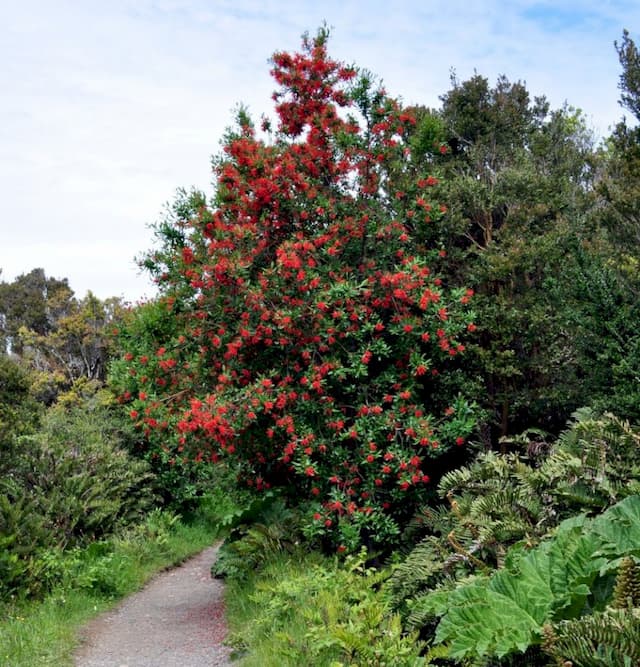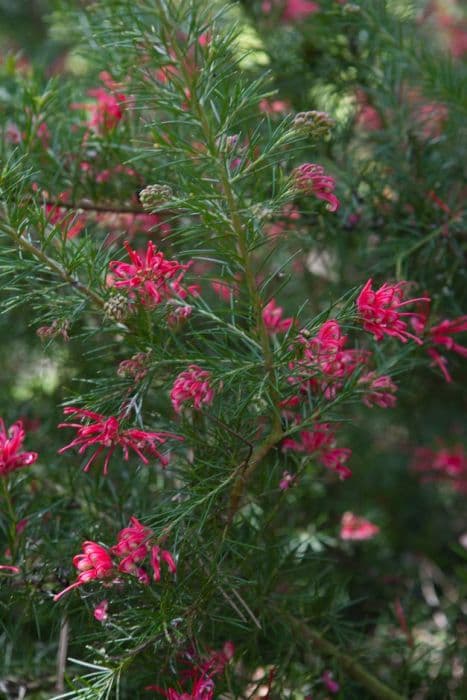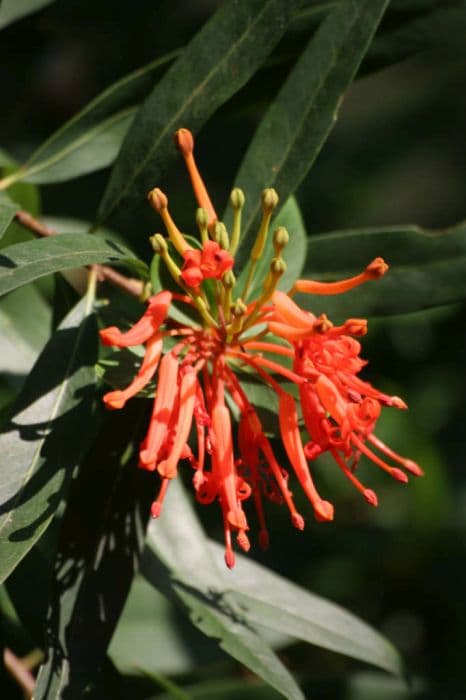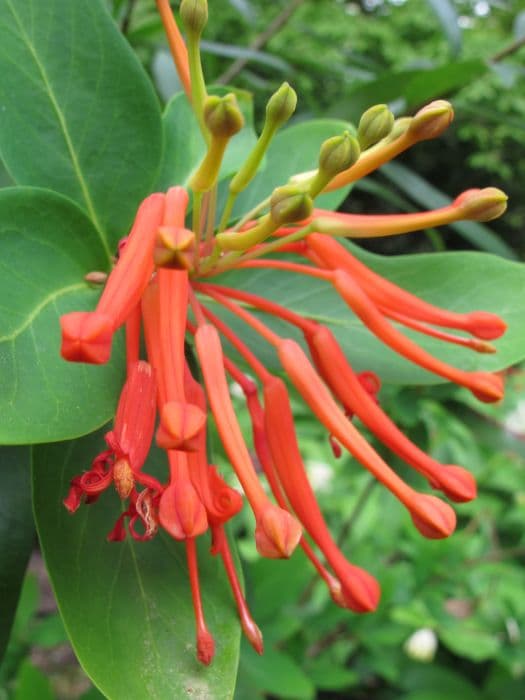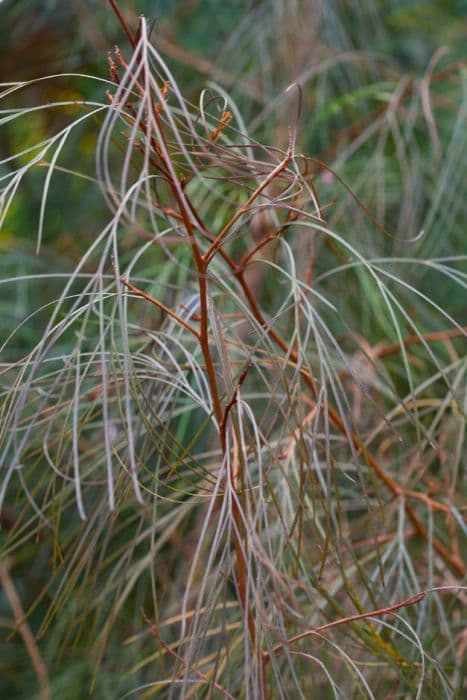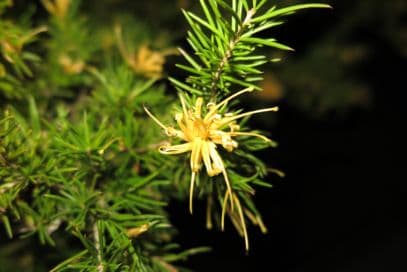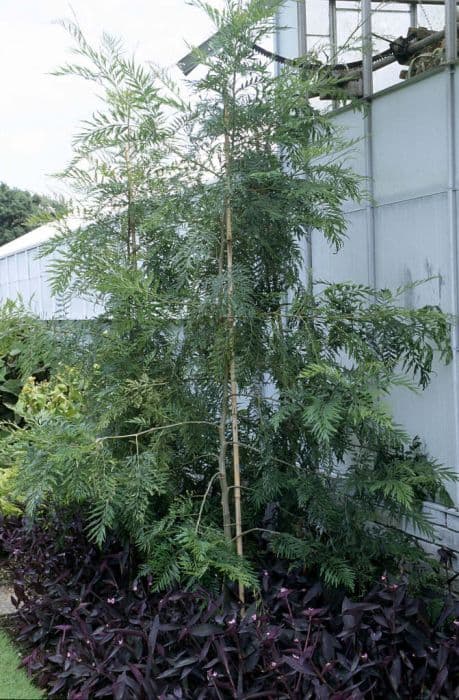Woolly Grevillea Grevillea lanigera 'Mount Tamboritha'

ABOUT
The plant known as Mount Tamboritha is a lush, evergreen shrub recognized for its attractive floral and foliage features. It sports a profusion of soft, small leaves that have a fine, woolly texture, giving the plant a dense and bushy appearance. These leaves exhibit a grey-green hue that provides a neutral yet pleasing backdrop in the garden throughout the year. Mount Tamboritha is adorned with unique, spider-like flowers that draw the eyes of onlookers. The blossoms can range in color, usually presenting shades of pink to a rich, rosy red, with styles that add an eye-catching contrast by often being a lighter tone. These flowers are not only visually appealing but also serve as a nectar source, attracting a variety of pollinators including birds and bees. The bloom spikes of this plant display numerous individual flowers, which collectively create a striking visual impact when the plant is in full flower. The flowering period is long-lasting, offering colorful displays for extensive periods. The combination of soft, textured foliage and vibrant, unusual flowers makes Mount Tamboritha a favored choice for garden enthusiasts seeking to add form, color, and wildlife interest to their landscapes. The striking appearance of this plant, with its soft foliage and captivating blossoms, allows it to integrate harmoniously with other plants or stand as a focal point on its own.
About this plant
 Names
NamesFamily
Proteaceae
Synonyms
Woolly Grevillea, Mount Tamboritha Grevillea
Common names
Grevillea lanigera 'Mount Tamboritha'.
 Characteristics
CharacteristicsLife cycle
Perennials
Foliage type
Evergreen
Color of leaves
Green
Flower color
Pink
Height
1-2 feet (0.3-0.6 meters)
Spread
2-3 feet (0.6-0.9 meters)
Plant type
Shrub
Hardiness zones
8
Native area
Australia
Benefits
 General Benefits
General Benefits- Attracts Wildlife: Grevillea lanigera 'Mount Tamboritha' is known to attract birds and insects, including beneficial pollinators like bees, due to its nectar-rich flowers.
- Drought Tolerance: Once established, this plant is highly drought-resistant, making it ideal for low-water gardens and dry climates.
- Low Maintenance: It requires minimal care once established, with no need for regular watering or fertilizing, making it a great option for gardeners seeking low-maintenance plants.
- Erosion Control: The plant's dense growth habit and extensive root system can help stabilize soil and prevent erosion on slopes or banks.
- Year-round Interest: With evergreen foliage and long flowering periods, it provides visual interest throughout the year.
- Landscape Versatility: Its compact size and mounding habit make it a versatile choice for various landscapes, including borders, containers, and rockeries.
- Quick Growth: The plant tends to grow quickly, providing rapid coverage and visual impact in new or renovated garden spaces.
- Adaptable: It adapts well to a variety of soil types, although it prefers well-draining soil and can tolerate coastal conditions, including salty winds.
- Non-invasive: Unlike some other plants, Grevillea lanigera 'Mount Tamboritha' is not known to be invasive, reducing the risk of it outcompeting native flora.
- Frost Tolerance: The plant can also withstand light frosts, making it suitable for gardens in cooler climates that experience occasional frosts.
 Medical Properties
Medical PropertiesThis plant is not used for medical purposes.
 Air-purifying Qualities
Air-purifying QualitiesThis plant is not specifically known for air purifying qualities.
 Other Uses
Other Uses- Grevillea lanigera 'Mount Tamboritha', commonly known as Woolly Grevillea, can be used as a natural dye source, where different parts of the plant, such as leaves and flowers, may yield dyes for fabric coloring.
- The dense foliage provides excellent habitat for small birds, offering both shelter and nesting opportunities.
- Its intricate flowers can be used in floral arrangements as a unique and long-lasting addition.
- The plant's wood may be utilized in woodworking projects for specialty items, primarily decorative due to its limited size.
- The Woolly Grevillea can serve as a living mulch, covering the ground and minimizing weed growth while also conserving soil moisture.
- It can be used in erosion control efforts, thanks to its spreading habit and the fact that it establishes strong root systems that help to stabilize the soil.
- The dried seed pods can be used in craft projects or as part of decorative displays.
- Due to its attractive foliage and flowers, this plant can be used in themed gardens to recreate the look of wild Australian landscapes.
- The nectar from its flowers can be a food source for making a sweet syrup or used to flavor beverages and desserts.
- Used in photography as a subject for macro photography due to the interesting texture and form of its leaves and blooms.
Interesting Facts
 Feng Shui
Feng ShuiThe Woolly Grevillea is not used in Feng Shui practice.
 Zodiac Sign Compitability
Zodiac Sign CompitabilityThe Woolly Grevillea is not used in astrology practice.
 Plant Symbolism
Plant Symbolism- Endurance: The Grevillea lanigera 'Mount Tamboritha', also known as Woolly Grevillea, is a hardy plant known for its ability to endure harsh conditions, symbolizing the strength to withstand life’s challenges.
- Protection: Woolly Grevillea's dense foliage offers protection to birds and other wildlife, representing shelter and safety.
- Adaptability: As this plant can adapt to a variety of soil types and climates, it symbolizes versatility and the ability to thrive in diverse environments.
- Resilience: Woolly Grevillea has a resilient nature, often able to recover from environmental stresses, signifying recovery and the power to bounce back from adversity.
- Diversity: The variety of forms and colors of Woolly Grevillea represents diversity and the beauty of unique characteristics in individuals and communities.
 Water
WaterThe Woolly Grevillea prefers to be watered regularly, especially during long dry spells, with decreased watering in the winter months. It is drought-tolerant once established but performs best with consistent moisture. Provide about 1 gallon of water weekly during the growing season, and adjust based on rainfall, lessening the amount as the plant matures. It's crucial not to overwater as the plant doesn't like to sit in wet soil, so ensure good drainage. During the heat of summer, watering may be increased to twice a week if temperatures are consistently high.
 Light
LightWoolly Grevillea thrives in full sun to partial shade. For the healthiest growth and best flowering, place it in a spot where it will receive at least six hours of direct sunlight daily. Light shade is beneficial in hotter climates to protect it during the peak afternoon heat.
 Temperature
TemperatureWoolly Grevillea is hardy and adapts to a wide range of temperatures, enduring minimum temperatures down to about 20 degrees Fahrenheit. They flourish in conditions that don't typically drop below freezing. The ideal temperature range for this plant is between 50 and 70 degrees Fahrenheit. However, it can tolerate short periods of colder and hotter temperatures as long as they are not extreme.
 Pruning
PruningWoolly Grevillea should be pruned to maintain shape and encourage bushier growth. Pruning is also beneficial for removing any dead or diseased wood. It is best to prune after flowering but doing so lightly throughout the year is acceptable. Pruning can stimulate new growth, which can lead to more flowers during the next blooming season.
 Cleaning
CleaningAs needed
 Soil
SoilWoolly Grevillea thrives in well-draining, slightly acidic to neutral soil with a pH of 6.0 to 7.0. A mix containing equal parts of loam, sand, and peat is ideal to ensure proper drainage and aeration, essential for preventing root rot. Regular checks for soil moisture and quality will maintain optimal growing conditions.
 Repotting
RepottingWoolly Grevillea should be repotted every 2 to 3 years or when it outgrows its current pot. It's crucial to use a fresh soil mix that meets the afore-mentioned requirements during repotting. This will encourage healthier growth and prevent the plant from becoming root-bound.
 Humidity & Misting
Humidity & MistingWoolly Grevillea prefers moderate humidity levels but is adaptable to a range of conditions. Ensure that indoor environments aren't excessively dry; however, it does not require the high humidity that tropical plants might need.
 Suitable locations
Suitable locationsIndoor
Place in bright, indirect light and ensure pot has drainage.
Outdoor
Plant in sunny spot with well-drained soil, protect from frost.
Hardiness zone
8-11 USDA
 Life cycle
Life cycleGrevillea lanigera 'Mount Tamboritha', commonly known as Woolly Grevillea, begins its life cycle as a seed, typically dispersed by wind or animal activity. After germination, which requires exposure to moisture and favorable temperatures, the seedling emerges and establishes a root system. As it grows into a juvenile plant, it develops its characteristic narrow, woolly leaves and begins to form a woody stem structure. Upon reaching maturity, Woolly Grevillea produces an abundance of red, pink, or cream spider-like flowers, attracting birds and insects that assist in pollination. After successful pollination, it sets fruit, which are follicles containing seeds ready for the next generation of plants. Woolly Grevillea can live for many years, continuously flowering and setting seed, contributing to the perpetuation of the species.
 Propogation
PropogationPropogation time
Spring to Summer
The Grevillea lanigera 'Mount Tamboritha', commonly known as Woolly Grevillea, is typically propagated through semi-hardwood cuttings. The best time to take cuttings for propagation is during the late summer to early fall. To propagate using this method, a cutting of about 4 to 6 inches (10 to 15 centimeters) is taken from the semi-hardwood section of the plant, which is neither the newest growth nor the oldest wood. The leaves on the lower half of the cutting are removed, and the cut end is often dipped in a rooting hormone to encourage root development. The treated cutting is then placed in a well-draining potting mix and kept in a warm, humid environment until roots have developed, which usually takes several weeks. During this period, it's crucial to keep the soil consistently moist but not waterlogged to prevent the cutting from rotting. Once the cutting has rooted and shows new growth, it can be transplanted into the garden or a desired container.

